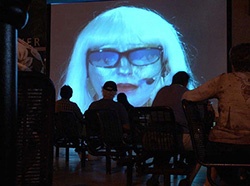Jul 24 2008
New-media art installations that caution visitors about a future when books are relics of the past, and nanoparticles represent a pervasive threat to human health, will be on display starting August 4 at the gallery @ calit2 on the campus of the University of California, San Diego.
 Virtual InfoSpherian character in Adriene Jenik’s SPECFLIC 2.6 installation is the reference-desk librarian in a world where books only exist in digital repositories.
Virtual InfoSpherian character in Adriene Jenik’s SPECFLIC 2.6 installation is the reference-desk librarian in a world where books only exist in digital repositories.
The joint exhibition will present “SPECFLIC 2.6” by UC San Diego Visual Arts professor Adriene Jenik, and “Particles of Interest” by *particle group*, an art collective composed of independent and UCSD-based artists and writers.
The art installations ask the viewer to consider a not-so-distant future in which individuals will be intimately connected to networks not only through our computers, but via nanoparticles in or on our own bodies.
The gallery is part of the UCSD division of the California Institute for Telecommunications and Information Technology (Calit2).
SPECFLIC 2.6
Today accessibility to information is a combination of video, image and text, informed in large part by the language of film and the literary novel. Adriene Jenik, in her ongoing project SPECFLIC, currently in version 2.6, explores the evolution of film language as “Distributed Social Cinema.” Using multiple screens, from cell phone interfaces to large image projections, Jenik layers media and technology forms. SPECFLIC 1.0 premiered at the dedication of Atkinson Hall as Calit2’s headquarters on the UCSD campus in 2005; SPECFLIC 2.0, hosted by the San Jose Public Library, was a featured event at ISEA06/ZeroOne San Jose in 2006.
For the gallery@calit2, Jenik offers the public a speculative, futuristic reality taking place in the year 2030, in which people access the “InfoSphere” to learn about books that are only available to the public in electronic form. In SPECFLIC 2.6, books exist as rare objects that can only be described by the InfoSpherian, who is a rough equivalent to today’s reference-desk librarian. Gallery visitors will be able use their cell phones to share their reflections on the future of the book and the library.
“Granted the opportunity for networked interaction within the gallery, for SPECFLIC 2.6 I have rethought the installation to integrate audience contributions,” said Jenik. “So the project is very much evolving in response to what I learn from each previous iteration, as well as the opportunities afforded by the space, encounter with the audience, and technological framework.”
SPECFLIC 2.6 offers a plausible future that is in large part dependent on a network with defined boundaries that are modeled after, or part of, the Internet.
Particles of Interest
In juxtaposition, “Particles of Interest” reflects on nanotechnology, which has no clear boundaries because it links humans to machines in ways that are beyond binary networks. Nanotechnology is an interdisciplinary field at the crux of scientific research and corporate investment. Research on nanoparticles has led to the commercial development of products such as improved rubber tires, coating in glass that makes it easier to clean, improved water filtration systems, sunscreen lotions and much more. At the same time, there has been little consideration of the health implications of nano-products.
The *particle group* installation allows visitors to learn about growing concern with nanoparticles in public health. Videos comment on the production of nanotechnology, and visitors can discover whether they have nanoparticles on their skin or clothing by interacting with sculptural devices.
Each iteration of the “Particles of Interest” project has been, as much as possible, site-specific. “This version of the piece functions as an access route to Calit2’s gallery, so we became interested in the pedestal and the host of scripts it serves in the gallery or museum,” said the artists. “Pedestals are used to elevate that which the institution has designated to be of value… and here in the Nano3 labs at Calit2, we find the laboratory cousin of the pedestal – the clean white (or aluminum) counter, whose contents may only be intimately accessed by professionals. Visitors to Calit2’s nanolabs are positioned to watch skilled nanolab professionals perform a range of interactions with nanoparticles. In our piece, we wanted our ‘unskilled’ visitors to perform this meeting with the untouchable in a different way. We wanted to bring the clean room and the gallery pedestal together, to see what they might have to say to each other.”
Elements of “Particles of Interest” and SPECFLIC were on view recently at the San Diego Museum of Art as part of its “Inside the Wave” exhibition, which featured new-media works from Southern California- and Tijuana -based artists.